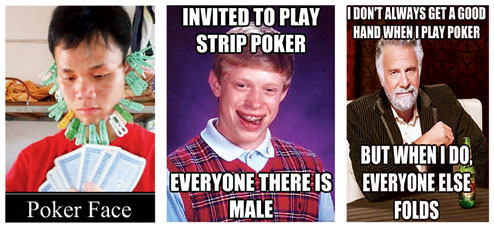 |
Poker is a card game played by three or more people, and unlike many other card games involving a 52-card deck, what sets it apart is the money at stake. You can bet a certain amount, and if luck and skill are on your side, you can come out with double or more! Here’s a guide to help you fill those pockets this Diwali.
First, the basics of the game. There are 10 rankings you have to follow, from highest to lowest. These are also called “orders” or “patterns”.
Each player is dealt two cards and the rest are kept in the middle. From the deck, three random cards are initially taken out and placed on the table. Each player has to see what is the highest pattern he can make with the three cards on the table and the two secret cards in his hand.
The person who is to the left of whoever dealt the cards starts the game. He has to “chip” a certain amount to begin the game and the person who is next can choose to remain in the game by chipping the same amount, or if he is more confident, by “raising” the amount. The person next to him, to stay in the game, will either chip the same amount or raise it and so on.
A player also has the option of “folding”, where he opts out of this round and does not chip any money if he’s not satisfied with the cards. After one round of chipping and/or folding, two more cards are taken out from the deck and placed next to the three on the table.
The target is to now make the highest pattern possible with five cards out of the seven at your disposal — five from the deck and the two in your hand. The person who creates the highest pattern will win all the money that has been bet.
The patterns in order of highest to lowest are ranked in the following manner:
1. Royal flush: Next-to-impossible to get, this pattern includes the order of ace, king, queen, jack and number 10 of the same suit, that is, all hearts, spades, diamonds or clubs.
2. Straight flush: Five consecutive cards of the same suit. For example, 9,8,7,6,5 — all of hearts.
3. Four of a kind: Four aces and any other card.
4. Full house: Three aces and two of the same cards in different suits. For example, ace of hearts, ace of clubs and ace of diamonds plus, king of hearts and king of spades.
5. Flush: Any four cards of the same suit and the jack of spades.
6. Straight: Five sequential cards, all of different suits. For example, 5 of hearts, 4 of spades, 3 of diamonds, 2 of clubs and ace of spades.
7. Three of a kind: Three cards of the same number of different suits and any two other random cards. For example, 10 of hearts, 10 of spades and 10 of clubs and 2 of clubs and 5 of diamonds.
8. Two pair: Two cards of the same number in different suits, two other cards of the same number in different suits and one random card. For example, 2 of diamonds and 2 of clubs, 5 of hearts and 5 of clubs, plus 7 of spades.
9. One pair: Two cards of the same number of different suits and three random cards. For example, ace of hearts and ace of spades, plus any three cards.
10. High card: If no one manages to make a pattern, the person with the highest order wins.
Now, there are a few tricks that one should remember in poker:
Try not to chase cards. This means making a bet based on the two unseen cards and hoping they help you create a higher pattern.
Learn the hierarchy by heart. Remembering the order of patterns correctly helps you decide how much you want to bet.
Learn to read “giveaways” of other players. Everyone has something — from a satisfied smirk or a too-calm expression to a frown — indicating whether they will raise or fold.
Remember, others are looking for your tell-tale signs as well. So, no matter what cards you get, keep the famous poker face!
Always keep track of the many combinations possible once you join your cards to the ones on the table. You may initially think of a “straight” but later realise that you could do a “flush” as well, so always think of the higher combination.
Bet smart. Bet a big amount only and only if you’re very sure that you have the highest order.
More importantly, don’t be afraid to “fold” if you think you don’t have good cards.
If possible, keep a note of all the money you have been betting and all the money you can still bet from the amount you have decided for the whole night. If possible, keep an account of the amount others are betting as well.
Try bluffing. Even if you think you don’t have the highest order, raise your stake and act like you do. Someone who may actually have a higher order than you might fold in anticipation.
Last but not the least, use your intuition and court Lady Luck.
Compiled by Sanjana Ray











